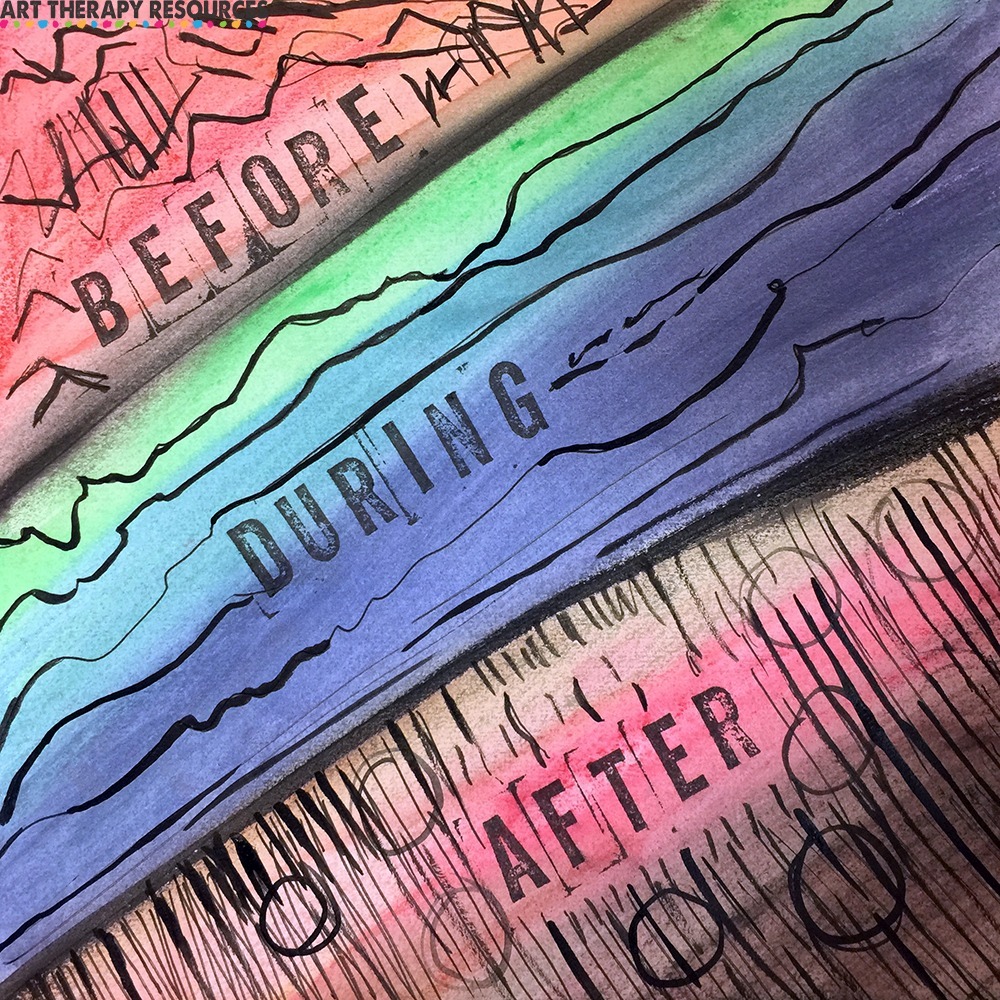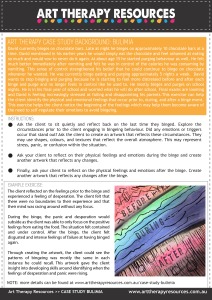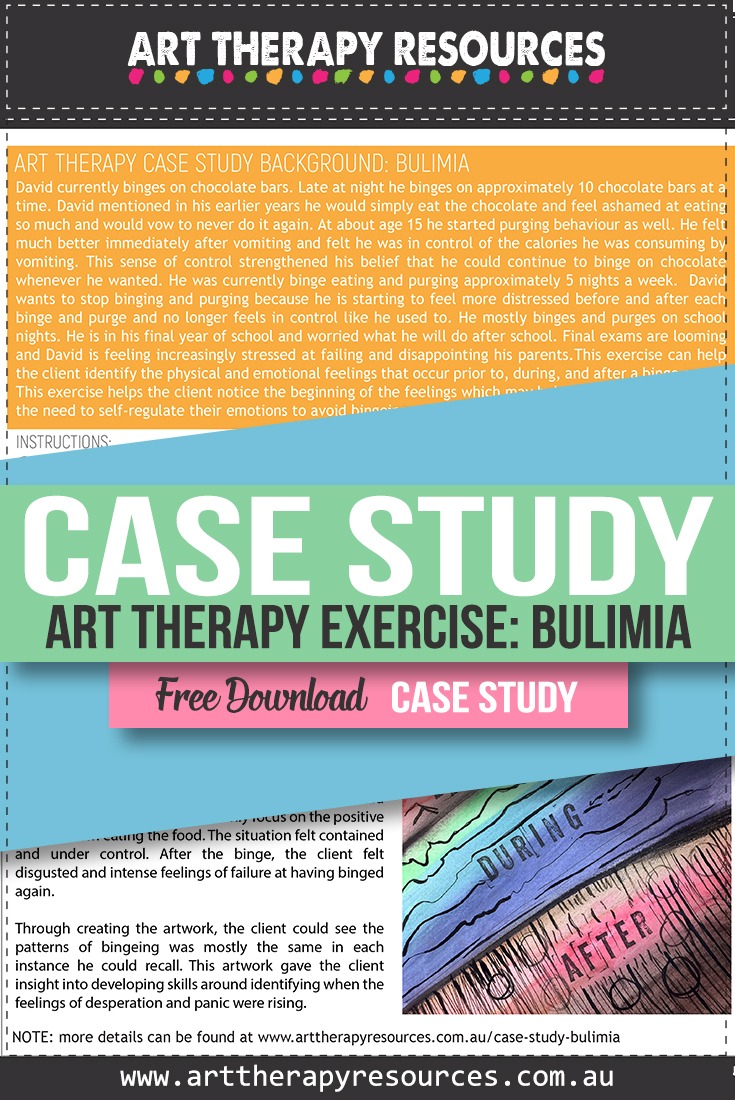THIS POST INCLUDES:
- Art Therapy and Bulimia
- About the Client
- Current Client Issues
- Art Therapy Exercise
- Client Insight and Outcomes
- Disclaimer
- FREE DOWNLOAD Art Therapy Exercise
ART THERAPY AND BULIMIA
It is common for people to experience unhappiness with body image, and use the control of food through dieting to attempt to affect change. It is common for many people to use food as a coping mechanism to deal with negative feelings. Using food in this way does not always suggest the presence of an eating disorder as eating disorders are a result of a dysfunctional relationship between eating, food and body image.
Eating disorders also have a multitude of negative psychological outcomes such as:
- Low self-esteem
- Shame and guilt for hiding eating disordered behaviours
- Perfectionism and obsession followed by subsequent disappointment at not meeting self-imposed standards
- Depression and anxiety
- Social isolation
Art therapy can play an integral part in addressing some of these experiences by encouraging the expression of emotions surrounding body image, self-esteem, and overall mood. Through art therapy, clients can explore their perception of body image and be able to express the shame, guilt and other dysfunctional beliefs they may struggle to express verbally.
Exploring creativity helps the individual engage in the process of personal expression where the focus is on self-exploration instead of ‘beautified’ outcomes. It is the role of the Art Therapist to emphasize non-judgment in art therapy sessions.
Art therapy can be used as a mindfulness technique to help the individual stabilize moods, and reducing anxiety and fears. Art therapy can also be used as a distraction technique if the individual is attempting to delay bingeing or purging activities. In this instance, art therapy will enable the individual to use creative self-expression as a coping technique.
CHARACTERISTICS OF BULIMIA
While most eating disorders centre around the use of food bulimia is an eating disorder with it’s own characteristics including:
- Binges and purging
- Dysfunctional view of body Image
- Emotion dysregulation
- Disordered eating
HOW ART THERAPY CAN HELP WITH BULIMIA
Art therapy can be a valuable tool in the recovery process of individuals with eating disorders. It can be introduced as an alternative coping skill where patients are encouraged to creatively express difficult and overwhelming feelings and emotions that are otherwise expressed through the control of food. Art therapy gives form to feelings, concerns, and stress which can be understood and addressed.
Some benefits of art therapy in the treatment of eating disorders include:
- Understanding, learning and coping with difficult and overwhelming feelings and emotions in healthy ways
- Help in seeing problems from a different perspective
- Creative problem solving
- Discharge of strong emotions
- Stress relief
- Increased awareness and communication around the illness
ABOUT THE CLIENT
- Name: David
- Age: 17
- Summary of sessions to date: In David’s first session he mentioned he thinks he is fat and has battled with his weight since he was about 12 years old. David’s BMI is currently in the normal range.
CURRENT CLIENT ISSUES
David currently binges on chocolate bars. Late at night, David binges on approximately 10 chocolate bars at a time. David mentioned in his earlier years he would simply eat the chocolate and feel ashamed at eating so much and would vow to never do it again. At about age 15 David started purging behaviour as well. David felt much better immediately after vomiting and felt he was in control of the calories he was consuming by vomiting.
This sense of control strengthened his belief that he could continue to binge on chocolate whenever he wanted. David was currently binge eating and purging approximately 5 nights a week.
David wants to stop binging and purging because he is starting to feel more distressed before and after each binge and purge and no longer feels in control like he used to. David mostly binges and purges on school nights. David is in his final year of school and worried what he will do after school. Final exams are looming and David is feeling increasingly stressed at failing and disappointing his parents.
ART THERAPY EXERCISE
This exercise can help the client identify the physical and emotional feelings that occur prior to, during, and after a binge event. This exercise helps the client notice the beginning of the feelings which may help them become aware of the need to self-regulate their emotions to avoid bingeing.
INSTRUCTIONS:
- Ask the client to sit quietly and reflect back on the last time they binged. Explore the circumstances prior to the client engaging in bingeing behaviour. Did any emotions or triggers occur that stand out?
- Ask the client to create an artwork that reflects these circumstances. They may use shapes, colours, and textures that reflect the overall atmosphere. This may represent stress, panic, or confusion within the situation.
- Ask your client to reflect on their physical feelings and emotions during the binge and create another artwork that reflects any changes.
- Finally, ask your client to reflect on the physical feelings and emotions after the binge. Create another artwork that reflects any changes after the binge.
SUPPLIES USED INCLUDE:
- Black Fude Ball Pen http://amzn.to/2k9pjhB
- Caran d’Ache Classic Neocolor II Water-Soluble Pastels http://amzn.to/2ggNU4K
- Simply Simmons Brushes http://amzn.to/2hramK7
- Versafine Black Ink Pad http://amzn.to/2mr96cr
- Block Alphabet Stamps http://amzn.to/2mS6bHd
- XL Watercolour Pad (trimmed to 12×12 inch) http://amzn.to/2gGdja2
- Water Bottle
CLIENT INSIGHT AND OUTCOMES
The client reflected on the feelings prior to the binge and experienced a feeling of desperation. The client felt that there were no boundaries to their experience and that their mind was racing around without any focus. During the binge, the panic and desperation would subside as the client was able to only focus on the positive feelings from eating the food. The situation felt contained and under control. After the binge, the client felt disgusted and intense feelings of failure at having binged again.
Through creating the artwork, the client could see the patterns of bingeing where mostly the same in each instance he could recall. This artwork gave the client insight into developing skills around identifying when the feelings of desperation and panic were rising.

DISCLAIMER
This case study represents a snapshot of the client’s progress in treatment. The exercise in this article could be used as written or as a guide for new and original tasks developed by the Art Therapist. Responsibility for treatment resides with the individual therapist who understands their clients specific needs. The art therapy exercise should not be viewed as a pre-defined directive on how to treat a client that presents with a specific range of problems.This art therapy exercise will help build a database of knowledge to draw upon when helping your client. Art Therapy is associated with psychotherapy techniques, however each therapist often approaches therapy with their own foundation of psychological interventions, whether it be psychotherapy, CBT, DBT or other methods.
FREE DOWNLOAD: Art Therapy Exercise
Download the FREE Art Therapy Exercise based on the above Case Study. The free download includes instructions for the art therapy exercise, along with an example of the art therapy exercise.

BUILD YOUR ART THERAPY REFERENCE MATERIALS:
Pin this image to your Pinterest board.

SHARE KNOWLEDGE & PASS IT ON:
If you’ve enjoyed this post, please share it on Facebook, Twitter, Pinterest. Thank you!
